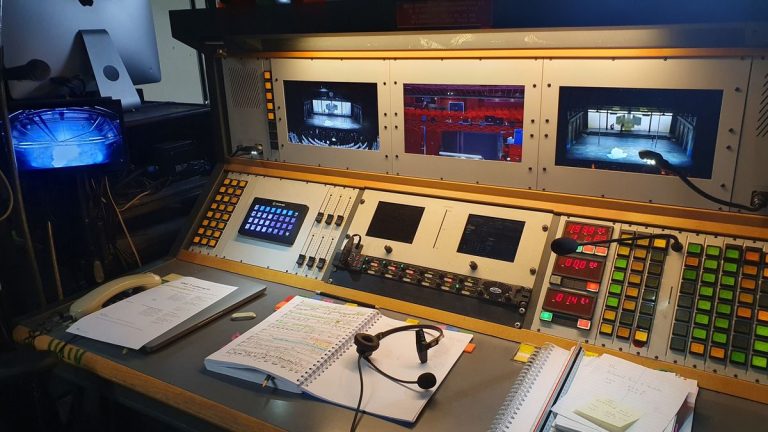The Dutch National Opera and Ballet offers an extensive repertoire that combines the Dutch National Opera, the Dutch National Ballet and the Netherlands Symphony. To immerse its theater visitors, they needed a new, future-proof audio-visual system to meet the necessary system requirements. The Dutch National Opera and Ballet leveraged SDVoE technology for a network-based system to connect audio, video and other components while enhancing flexibility for future improvements.
The stage
The historic theater complex is located in the heart of Amsterdam, at the bend of the Amstel River, and is home to the Amsterdam City Hall and the Dutch National Opera and Ballet. The theatre, which opened in September 1986, comprises various rooms, including a 1,600-seat auditorium on three levels, an atrium with a panoramic view of the Amstel River, and additional smaller private rooms and studios for special events and rehearsals.
[Immersive WWII ‘Expressions’ in New Orleans]
The Dutch National Opera and Ballet creates, produces and presents national and international performances in opera, ballet and the related musical and dramatic arts. It combines song, dance, music, acting, language, technique and design to create a vivid, captivating interpretation of human emotion.
The existing audio-visual equipment, which included a composite analog video system, was as old as the theater. “In 1986, analogue video technology was the preferred and only route to audio-visual systems,” explained Rutger Flierman, video engineer and programmer at the Dutch National Opera and Ballet. “We take advantage of real-time video transmission from the camera connected to the stage including stage management, bar operators, singers and off-stage orchestras. Over the years, the Dutch National Opera and Ballet has introduced new components to improve video quality, but unfortunately, new hardware has Latency.In addition, the user experience has become increasingly complex as new components are added to the audiovisual system.
“Unfortunately, the theater's cables have become too old to transmit high-definition images over long distances throughout the theater. As a result, picture quality has degraded, and stage managers and performers are unable to watch the conductor in a high-quality, interference-free live video stream.” Cumin.
[Everything We Know about the Vegas Sphere, So Far—A Running Blog]
SDVoE technology exceeds requirements
Ultimately, the Dutch National Opera and Ballet decided that many of the components had reached the end of their life cycle; Therefore, a new future-proof audio-visual system would meet the necessary system requirements.
The Dutch National Opera and Ballet required a system with low latency, high resolution and refresh rate. Fortunately, the SDVoE alliance went beyond the requirements of the Dutch National Opera and Ballet.
“The future is network-based,” Flerman said. “The flexibility of a network-based system enables us to add new devices in the future if needs or system requirements change.” I began researching network-based audio-visual systems, which led to the creation of the SDVoE Alliance. I was blown away by the courses “Free online training offered by the SDVoE Alliance, so I started taking their online design courses. It gave me access to the outlines and documentation needed to build a network-based AV system. Plus the entire course is free.”
[The ABCs of AVoIP, Part 1 | Part 2]
Flierman applied his knowledge from the SDVoE Academy to design a network-based audio-visual system. In collaboration with Will Hoogervorst Engineering (WHE), the team looked for cameras, monitors and a complete audio-visual solution to switch the image and fade it to completely black. This was achieved by modifying displays and the ability to send black video from any SDVoE enabled receiver.
As a result, Dutch National Opera and Ballet has benefited from the SDVoE Alliance ecosystem, including more than 700 solutions designed to integrate seamlessly and flexibly to create an integrated hardware and software platform for audiovisual distribution. SDVoE Alliance network architectures are based on off-the-shelf Ethernet switches, which have provided the Dutch National Opera and Ballet with significant cost savings, greater system flexibility and scalability compared to traditional approaches, such as point-to-point extension and circuit-switched AV matrix-based systems. It is worth noting that the SDVoE Alliance's open API allowed the Dutch National Opera and Ballet to exercise its creativity to create a customizable user interface for administrators, technicians and stage managers, allowing them to access multi-view and picture-in-picture content and remote camera control. And the sound turns black.
After extensive testing, the new low-latency monitoring system was implemented in 2023, at the beginning of the theatrical season, and all users, including conductors and singers, are very happy with the tremendous improvement and outstanding performance. SDVoE technology, as implemented by members of the SDVoE Alliance, has provided the Dutch National Opera and Ballet with a future-proof solution for distributing high-definition, low-latency video across the theater. The Dutch National Opera & Ballet can maintain the audiovisual system, create custom user interfaces designed to meet the specific needs of the theater, and implement new technologies by taking advantage of the flexibility of SDVoE technology.

